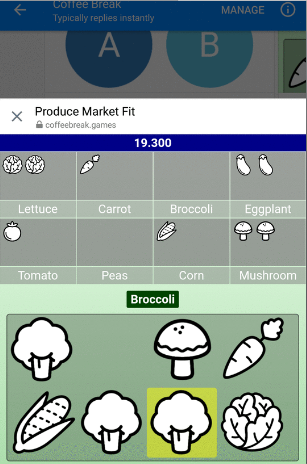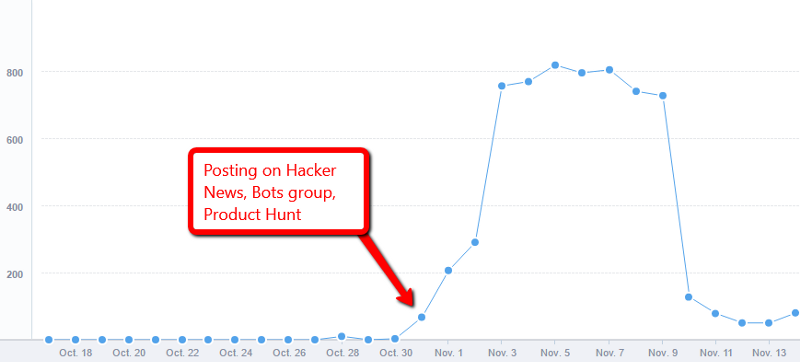Facebook Messenger Bot platform growth and trend observations
It has been just a little over 6 months since the launch of the Facebook Messenger Bot platform in April 2016. The platform has seen some development and evolution, but so far hasn’t been promising in the sense that there aren’t any “killer apps” on it yet.
I’m somewhat of a seasoned Facebook developer and a Facebook fan. When the Facebook app platform first went live in 2007, I happened to have a chance to work on it right away. (I was working in a small studio that developed web apps for clients, and everybody wanted to create a Facebook app at the time, so I got to get paid doing it. That experience eventually lead me to join Zynga in mid 2008, a pure Facebook games company at the time, and where I worked for the next 6 years.)
Fast forward to mid 2016, the launch of the Facebook Messenger Bot platform. This time around, my job is not in the area of bot development; however I’ve been involved in multiple hobby projects on the platform since day 1, and have seen its changes and trends. Here’s a little compare and contrast of the platforms and the experience so far.
Platform Goals
These are my thoughts and not the official stance of Facebook. Here’s what I think Facebook should be aiming for:
- Platform growth similar to that of the Facebook apps platform
- Killer apps in terms of ubiquitous use by users
Here is what I think Facebook’s learning was from the first time around, and is trying to avoid falling into:
- Platform becoming spammy due to liberal uses of communication channels (notification, newsfeed)
- Keeping the platform useful by encouraging utility and lifestyle apps, and not let it “devolve” into a games platform like the Facebook apps platform
Platform growth and killer apps: Time-line comparison with Facebook apps
This is what makes me go back and forth when thinking about the success of the Messenger Bot platform:
- The past 6 months feels like a lifetime on the platform, and it’s frustrating to see that so little progress has been made in terms of market adoption — none of my friends (besides the bot developers) use any bots on Messenger.
- On the other hand, the killer apps on the Facebook apps platform didn’t come around until 6–12 months after platform launch. Texas Hold’em Poker (Zynga Poker’s former name), Mob Wars, Mafia Wars, all appeared around this time frame; Restaurant City, FarmVille and other more graphical games came even later — well into the 18–24 months time frame of the platform. This does convince me to stay patient. However…
- Early apps on the Facebook apps platform were already very sticky, and gained mass adoption; even though they weren’t killer apps. These apps included things like Super Wall, Vampires and Werewolves, Friends For Sale, and a bunch more decoration/expression type apps from Slide and RockYou at the time. Many of these came along as early as 2–3 months into the platform. This is what is sorely missing on the Messenger Bot platform right now. We don’t even have the “fart apps” with massive adoption yet. (by absolute numbers, I’m sure there are more bot users now than there were apps users in early 2008, simply because the Facebook network itself is much larger now. The percentage of users is likely lower though; everybody had at least one of Super Wall, Fun Wall or Advanced Wall back then.)
Platform close-guarding by Facebook
There may or may not be an official statement from Facebook, but many of us got the impression that Facebook originally did not intend for their apps platform on the web to be games-focused. Utility apps were the big thing in mind and apps like Cities I’ve Visited (eventually acquired by TripAdvisor — one of the only successful apps on the platform that wasn’t a game) was what was in mind.
However, games turned out to be the killer apps and they rolled with it. Facebook Credits was released as a way to monetize the games on the platform, and eventually a whole games portal was built. Along the way, many viral growth channels that were originally designed as lightweight ways for apps to reach out to non-users of the apps, like notifications and feed posts, were changed and nerfed, because they were abused too much. From Facebook’s point of view, it made perfect sense — it made Facebook itself way cleaner and more friendly to use, but from the apps developers point of view, it was devastating as they lost the most effective channels to expose to new users.
The reason I went into this whole story is that I believe that’s what’s driving some of the design decisions on the Messenger Bot platform now:
- Viral channels are deliberately missing. Recently a Share button feature on a carousel template has been added, as a lightweight communication channel a user can use to share your bot. Before this, there was practically nothing. Even this new Share button though is currently very limited in terms of what can be done.
- The social graph (an API to access a user’s friend list) is obviously deliberately missing. Even if you have Facebook friends that are also users of your bot! I do think it would be a bit much to be able to access your entire social graph (which the Facebook apps platform did allow), but not having access to even friends of yours who are also users of the bot is very limiting in terms of creating a great social experience within the bot.
- It’s also lacking what is essentially a “newsfeed.” In other words, there is no passive way for a user to explore what his/her friends are using. This is a stark contrast with the Facebook apps platform, where it was abundant: 1) In the early days in 2007, Facebook profiles were visited very often, and the profile box modules allowed for very easy discovery of new apps. This was how apps like Super Wall grew quickly. 2) The Facebook newsfeed itself allowed posts to it all the way up until games heavily abused it and they had to scale back. But for all the games that came before it and could take advantage of it, growth was tremendous. For there to be an equivalent on Messenger, you’d need some sort of “homepage” on the Messenger app where you can see some of the bots that your friends are using. I don’t know how such a feature could make sense in design, I don’t even think it’s realistic to expect Facebook to design something like it. I’m merely pointing this out as a difference between the two platforms, as a reason why it’s harder to grow bots right now.
In the end, this all makes sense from Facebook’s perspective. If those channels were provided, one can see that the platform would very quickly be “polluted” by exactly the sort of apps and games that they are trying to avoid. From their F8 presentations, it’s very clear what type of bots and UX they are going for — flight tickets, flight check-ins, ordering flowers, ordering anything and getting receipts and talking to customer support. None of these are apps/bots where a viral channel would make sense for. Ironically though, this is also why the platform is struggling to gain traction. Let’s face it, there are now reportedly 34,000 bots on the Messenger Bot platform, but none of your friends (who’re not Facebook developers) use any. I’d wager 90% of your friends (outside of tech) don’t even know what bots are or that they exist on Messenger.
My experience — growth hacking using the only viral channel available
A couple of weeks ago, I built an experimental project on the Messenger Bot platform. Taking my learning from a previous failed project I was involved in, and using the new “Share” button feature that was just announced at the time, I decided to see if I could build an app that emulated the success of some of the apps in the original Facebook apps platform.

The idea is simple — mini games that are essentially quick twitch games where you get a high score, and you’re encouraged to share a score to challenge friends to beat your score. The game is Coffee Break (direct Messenger link if you’re on mobile).
The experiment was somewhat of a success, though it didn’t last.

On the night of launch, I posted it to the Bots developer group, Hacker News and Product Hunt. I did not even account for best time of day to post, and just wanted to get it out as a test. It took off on its own. However, it didn’t last.
One of the main things that hurt growth was the amount of drop-off of users who did not even start a game after sending a message to the bot. Game spread via sharing was great at first, but many either did not figure out how to start playing a mini game, or was not interested.
The number of unique users who started any game at all, vs the number of total users who sent at least 1 message to the bot, is roughly around 50%. That means about 50% of users dropped off immediately after engaging with the bot.
From this quick experiment, I had 3 main take-aways:
- Viral growth on the platform is now possible with the new Share button; but it’s a much more deliberate action (compared to app invites, notification and feed posts before), and a Messenger channel is much more delicate. This means that a relevant share to the audience (whoever the user chooses the share with) is powerful, but it can become abuse/feel like abuse even more quickly than the old notification channel. Use carefully. (I’ve personally blocked a few Messenger Bot apps I tried out that wouldn’t stop messaging me even though I’m uninterested in continuing.)
- Passive exploration and discovery is still very much a problem. There is very little ways for a Messenger Bot app to get seen besides the viral channel mentioned above. For myself, after the posts on Bots group and Hacker News, there’s very little I could do to help push it forward. (I did a few things like submitting to botlist.co and trying a few dollars at Facebook ads, but nothing really helped.)
- User attitude and/or savvy-ness toward Messenger Bots. Assuming that users who share their high score chose friends who are likely to play to share with (as opposed to random spamming), the 50% drop-off number is disappointing. An assumption is that most users are either unaware what a bot is at all or what they are supposed to do with it, and only the more curious/courageous ones tend to play with it.
That about sums it up for my thoughts on the Messenger Bot platform for now! Overall, I’m excited to have a new platform to experiment with. I’m not yet fully convinced that chatbots / conversational UI is ready for the big stage right now with the platform where it is, but I’m optimistic it will get there. Leave your thoughts in the comments and heart the post if you like it!




